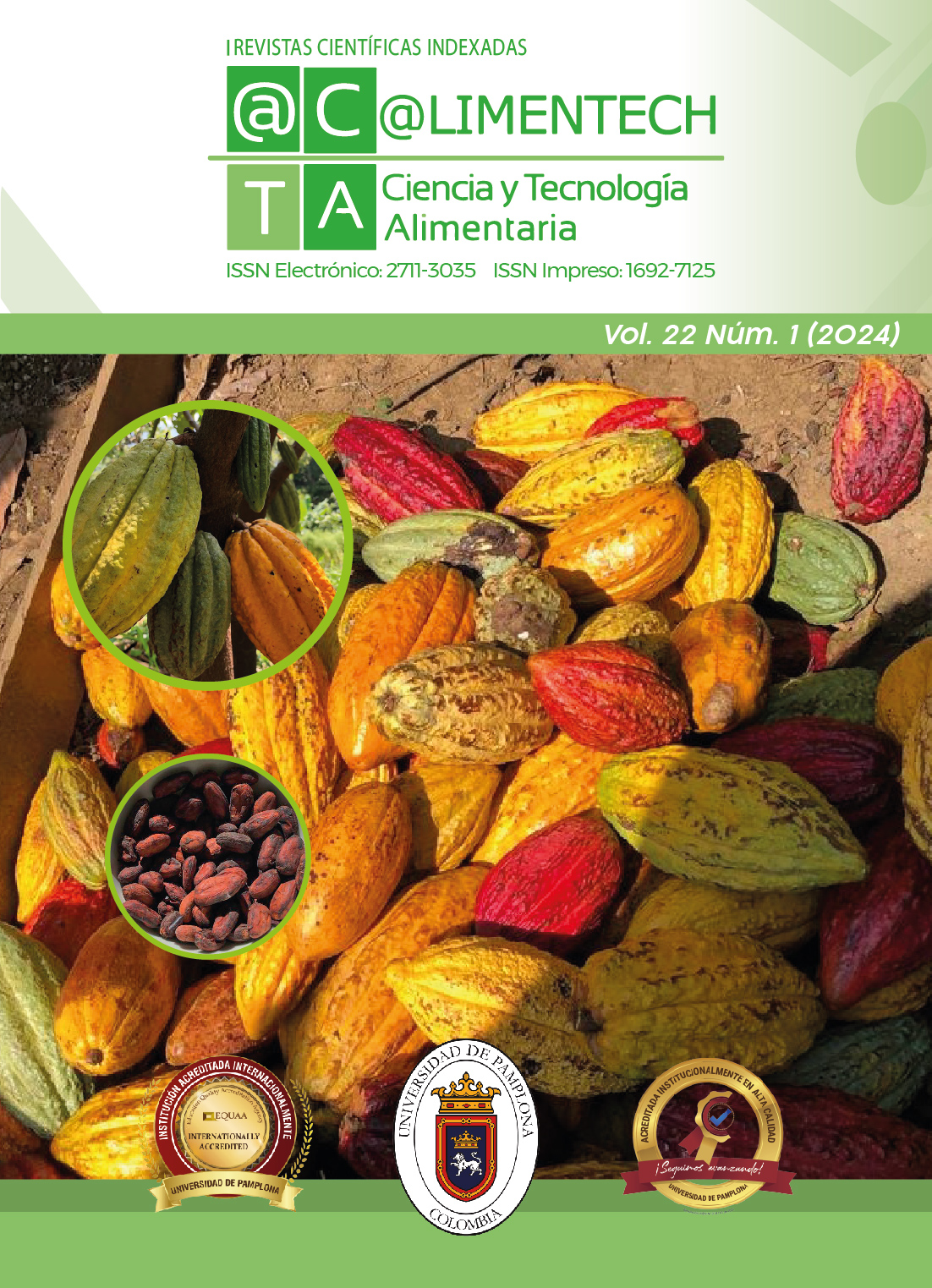Seguridad alimentaria en niños con diagnóstico de desnutrición aguda Cali: estudio de prevalencia
DOI:
https://doi.org/10.24054/limentech.v22i1.2864Palabras clave:
Desnutrición, estado nutricional, factores socioeconómicos, hambre, seguridad alimentariaResumen
La desnutrición constituye una disfunción entre el aporte energético y los requerimientos nutricionales corporales, por una alimentación inapropiada. Los niños son la población más afectada, por ello es de gran importancia la intervención en los determinantes sociales debido a las secuelas biológicas irreversibles que desencadena este evento. Esta investigación se realizó bajo un estudio cuantitativo de corte transversal, el tamaño de muestra fue de 117 familias cada una representando un menor de edad y del total de los participantes cada uno representaba un núcleo familiar: La población eran residentes de las comunas 13, 14, 15 y 21 de la ciudad Santiago de Cali. Se hizo la recolección de datos por medio del cuestionario Escala Latinoamericana y Caribeña de Seguridad Alimentaria (ELCSA). Como resultado se obtuvo a nivel de seguridad alimentaria: en 37 familias con seguridad alimentaria (31,6%), 46 familias con inseguridad alimentaria leve (39,3%), 18 familias con inseguridad alimentaria moderada (15,4%) y 16 familias con inseguridad alimentaria severa (13,7%); el 80% de los menores se encontraban bajo el cuidado de la madre las cuales se desempeñaban en las labores del hogar; el promedio de edad de los adultos encuestados fue de 28,6 años; solo el 44% contaba con nivel de estudios secundaria completa, y en el 48,7% de los hogares los ingresos económicos estaban avaluados en menos de $1.000.000COP. El nivel de seguridad alimentaria predominante fue seguridad, sin embargo, entre los integrantes se encontraba el integrante menor con desnutrición, situación que nos permitió identificar que los alimentos no suplían los requerimientos nutricionales para el adecuado desarrollo del infante.
Descargas
Referencias
Ávila, G. S. (2017). Desnutrición aguda moderada y severa en menores de cinco años. https://www.dadiscartagena.gov.co/images/docs/saludpublica/vigilancia/protocolos/p2018/pro_desnutricion_menor_5_2018.pdf
Carmona Silva, J. L. (2022). Validación cualitativa de la escala latinoamericana y caribeña sobre seguridad alimentaria (ELCSA): Caso San Felipe Cuapexco, Puebla / Qualitative validation of the Latin American and Caribbean scale on food security (ELCSA): Case of San Felipe Cuapexco, . Revista Trace, 81, 181. https://doi.org/10.22134/trace.81.2022.778
Cordero Herrera, A. M. (2014). Principales enfermedades asociadas al estado nutricional en el niño menor de un año. Medicentro Electrónica.
Cortázar, P. A., Giraldo, N., Perea, L., & Pico Fonseca, S. M. (2020). Relationship between food security and nutritional status: In indigenous children in north of Valle del Cauca, Colombia. Nutricion Clinica y Dietetica Hospitalaria, 40(1), 56–61. https://doi.org/10.12873/401pico
FAO - Organización de las Naciones Unidas para la Alimentación y Agricultura, (2012). Escala Latinoamericana y Caribeña de Seguridad Alimentaria.
Florida, L., & Calderón, L. L. (2010). Estado nutricional de menores de 5 años y seguridad alimentaria de sus hogares. Corregimiento La Florida, Colombia 2010. Fundación Universitaria Del Área Andina, 4(4), 34–40. http://revia.areandina.edu.co/ojs/index.php/vbn/article/view/500/533.
Gutiérrez-Zambrano, Merary; Garnica-Mayorga, Norma Rocío; Maldonado-Mateus, Lida Yaneth. (2022). Factores que intervienen en la calidad de vida nutricional de las reclusas del centro penitenciario y carcelario de Bucaramanga. Revista @limentech, Ciencia y Tecnología Alimentaria. ISSN Impreso 1692-7125 ISSN Electrónico 2711-3035. Volumen 20 N° 2. Pp: 113 – 130.
Jiménez-Jiménez, R. A., Rendón-Rendón , M. C., Chávez-Pérez, L. M. & Soler Fonseca, D. M. (2019). La polarización de los sistemas de producción pecuaria en México. Ciencia y Tecnología Agropecuaria, 4(1), 31-39. https://ojs.unipamplona.edu.co/index.php/rcyta/article/view/981/1118
Lissbrant, S. (2015). Seguridad alimentaria y nutricional en la región caribe: consecuencias de la desnutrición y buenas prácticas como soluciones. Investigación y Desarrollo. https://doi.org/10.14482/i&d.v23i1.6529
Ministerio de Salud y Protección Social (2020). Resolución No 2350 de 2020 (Issue 0).
Ospina Hernández, M. L., Macías Bolívar, K. M., Jassim Álvarez, B. R., Gómez Aguirre, S. M., & García Pacheco, Y. E. (2022). Seguridad alimentaria en familias y su relación con la malnutrición de niños en colegios de barranquilla. @limentech, Ciencia Y Tecnología Alimentaria, 20(2). https://doi.org/10.24054/limentech.v20i2.2280
República de Colombia. (1993). Resolución 8430 de 1993. In Ministerio de Salud.
Rodríguez Quirós, R. (2017). Seguridad Alimentaria: Evolución conceptual y relación con el cambio climático. Universidad En Diálogo: Revista de Extensión, 7(2), 97–105. https://doi.org/10.15359/udre.7-2.5
OMS - Organización Mundial de la Salud. (2022). Informe de las Naciones Unidas: las cifras del hambre en el mundo aumentaron hasta alcanzar los 828 millones de personas en 2021. Retrieved March 8, 2023, from https://www.who.int/es/news/item/06-07-2022-un-report--global-hunger-numbers-rose-to-as-many-as-828-million-in-2021
Semanal, B. E. (2023). Unidades de análisis y tableros de problemas , semanas epidemiológicas 01 a la 24 de 2023.
Descargas
Publicado
Número
Sección
Licencia
Derechos de autor 2024 @limentech, Ciencia y Tecnología Alimentaria

Esta obra está bajo una licencia internacional Creative Commons Atribución-NoComercial 4.0.








